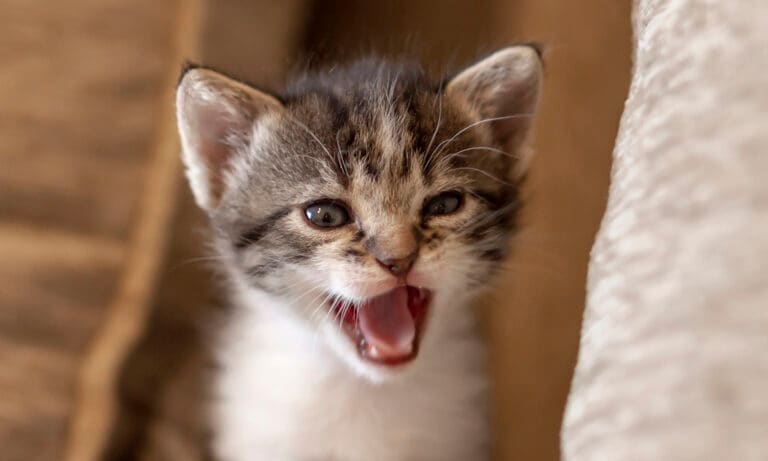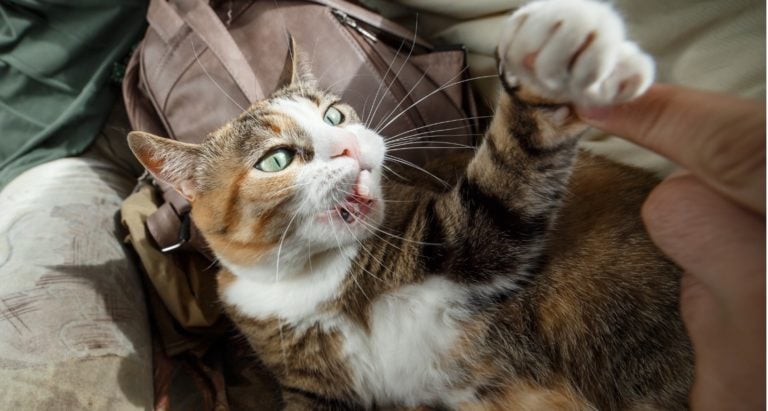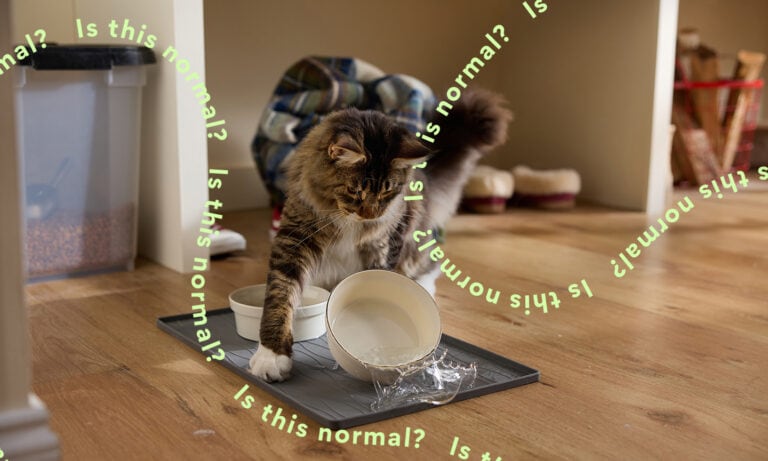Nothing beats a kitten for cute factor and fun, but when kitten behavior stages progress to the adolescent cat period, cat owners become frustrated trying to stop behavior problems. This juvenile delinquent kitten behavior is quite normal, and could be compared to human kids who want to challenge rules.
Cats, like dogs, test their independence during adolescence. This, combined with high energy, clueless inexperience and boundless curiosity, means they’re much more likely to get into trouble.
When Is A Kitty An Adolescent?
When my Karma kitten showed up last year, the veterinarian already estimated his age to be about 8 months, well into adolescence. He’s still going through some of the most common obnoxious behaviors. I think kittens are made “cute” so we fall in love early, and will put up with their antics long enough for them to settle into well-mannered adults.
Kitten development falls into several categories:
- Neonatal Period: Birth through week 2
- Transitional Period: End of Neonatal Period to week 3
- Socialization Period: Week 3 through week 9 to 10
- Juvenile Period: Week 10 until sexual maturity
- Adolescent (aka “delinquent”) Period: 6 through 18 months
Common Adolescent Cat Behavior Problems
1. Predatory/Play Aggression
Social play reaches its peak during early adolescence. That’s when “attack kittens” rev up with play aggression, and some of this continues beyond four months. In between the bursts of high-energy play, these kittens purr and lap-snuggle for forgiveness, but at about six to nine months that gives way to the adolescent behaviors. These cats want to push all your buttons, and this is the age when cats often lose their homes.
Adopting a pair of kittens can help, because they’ll have each other to play attack and burn up energy, rather than targeting your ankles. Use interactive toys like fishing pole lures to wear her out. Karma can’t get enough of chasing his furry mouse cat toy, and he also is delighted when Magic, our 90-pound German Shepherd, agrees to play chase.
2. Intercat Squabbles
When you live with more than one cat, the adolescent kitten can test the patience of your other cats. Karma desperately wants to play and roughhouse, and doesn’t have another cat his age for a playmate. He weighs more than twice as much as my 6-pound, 18-year-old cat Seren, and she is not amused when he chases her, grabs and hugs, and pesters for attention.
Some of intercat squabbling at this age happens when Junior-Cat challenges older cats to secure her social ranking within the cat community. Higher-ranking cats feel compelled to kick Junior’s furry tail to keep her in her place. Karma now also uses his pester-Seren-ploy to get my husband to come chase him — it’s his favorite game! Our solution to aggression includes separating the two by giving Karma a time-out when he can’t control himself. Tossing a towel over the top of wrangling cats interrupts the behavior and keeps you at a safe distance from accidental bites or clawing.
3. Scratching
All cats scratch, but during adolescence your kitten’s claws have grown stronger and can cause greater damage. Because they want to jockey for social status, marking behavior can increase. Adolescent cats often ramp up the scratch graffiti.
Teaching claw etiquette, by providing lots of acceptable opportunities, can help enormously, while making the unacceptable targets unattractive. Keeping the claws trimmed also is important so that when the cat forgets, there won’t be a problem. I began trimming Karma’s claws as soon as he arrived. He knows he gets tasty treats for putting up with the indignity, and a playtime chase-the-mouse game after.
4. Nighttime Crazies
Nighttime is prime cat time, and it’s normal cat behavior to prowl, yowl and play after dark. Of course, galloping up and down the stairs at 3 a.m. or nibbling on your nose and pouncing on toes tries the patience of the most understanding owner. Yes, Karma does this! All that kitten energy doesn’t shut down on the human’s schedule, and often when we go to bed, the adolescent kitty takes that as an invitation to have face-time. After all, when you’re in bed, the kitten doesn’t have to climb up your shirt to go nose-to-nose with you.
I convinced Karma that bedtime meant sleep time by giving him an instant time-out for two minutes behind the closed bathroom door, every single time he nibbled my nose or grabbed my feet under the covers. Yes, it took about four or five repeats for him to understand. The next night, it only required two time-outs. And thereafter, he only forgot himself a few times, and a single time-out reminded him of the rules. If all else fails, create a safe room across the house, complete with cat litter box, toys, water and cat bed, where your adolescent cat sleeps away from you. Oh, and invest in earplugs so you don’t hear her complaints.
5. Accidentally On Purpose
Curiosity, cluelessness and physical maturity mean your adolescent cat can jump higher, open more doors and cupboards, climb with ease, and dash away very quickly. All these combine to put her at higher risk for injury from falls, burns from walking on stovetops, becoming stuck behind doors or in hidey-holes. My cat Seren used to leap to the highest spot and play “gravity experiments,” knocking off breakables to watch them fall. Cat adolescence means you must focus on cat-proofing your home, and stay alert to all the trouble your cat wants to find.
6. Romantic Cats
Adolescent cats start noticing the opposite sex at this age. When romance is in the air, your young boy cat’s hormones prompt him to baptize everything in sight by spraying pungent urine. This scent-marking behavior advertises sexual status and availability to other cats. A girl cat’s heat behavior may include spraying, and she also becomes much more vocal when in heat/estrus. Female kitties in heat will roll and loudly yowl like they’re in pain, and will become escape artists to get out the door to meet hot dates, possibly becoming pregnant.
Spaying or neutering your young cat removes the hormones that stimulate these behaviors, and eliminates many of these objectionable behaviors. We were very fortunate that Karma had not yet begun spraying urine when he arrived at 8 months of age, and he was neutered immediately. The surgery is less likely to totally eliminate spraying behavior once your adolescent cat makes it a habit, so don’t delay!
A Time For Patience
During adolescence, growth spurts turn your chubby baby into a lanky, high-energy, teenage cat, with the attendant mix of hormones for extra fun. The larger size also means what were cute baby antics become obnoxious or even destructive and dangerous.
Shifts in personality happen during this time, from snuggle kitten to keep-your-distance cat, and vice versa. Kitty adolescence requires patience — she will outgrow this. Understanding what to expect and using these tips to deal with her hijinks can help you grin and bear it.
By: Amy Shojai
Featured Image: baipooh/Shutterstock.com
Share:









